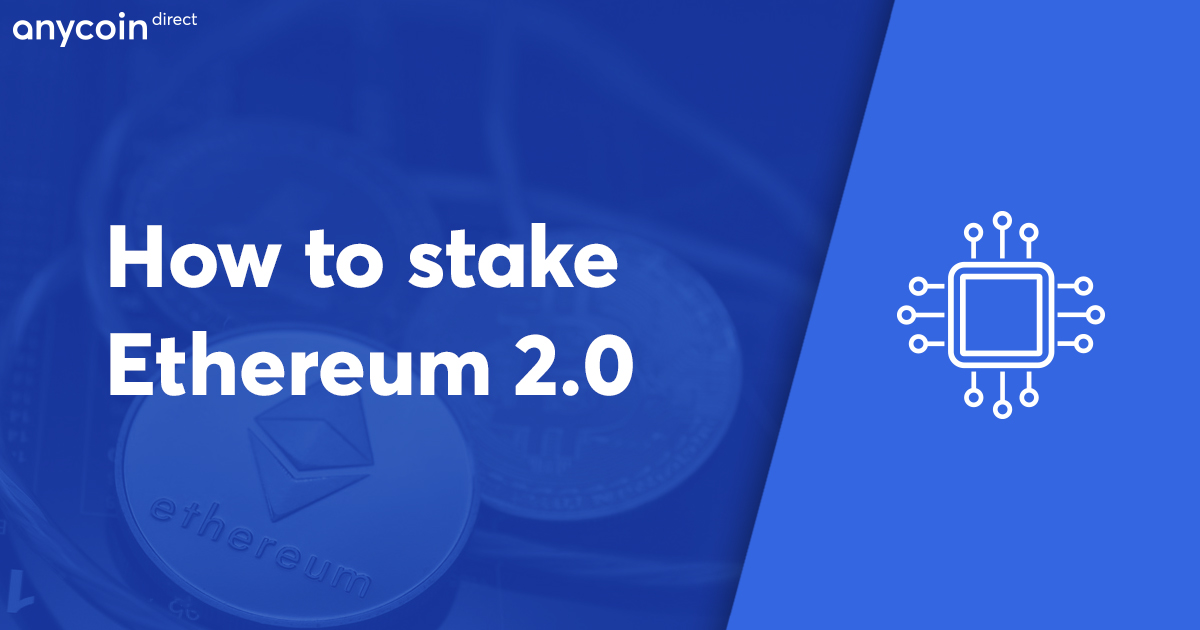How to stake Ethereum 2.0
- 15 minute read

The long awaited upgrade to the Ethereum 2.0 network is finally here. Ethereum aims to solve its security, scalability and sustainability problems. In this article you will learn everything there is to know about staking, and why this is a big step forward for Ethereum. If you don’t know what Ethereum 2.0 is all about, take a look at our articles about this project.

- Summary
- What is Ethereum 2.0?
- When will Ethereum 2.0 be released?
- How do I start staking Ethereum 2.0?
- What are the requirements to stake Ethereum 2.0?
- What hardware is recommended for staking Ethereum?
- The penalty system
- Risks
Summary
For all you lazy people out there, here is a short summary that will save you some time! Ethereum 2.0 aims to solve security, scalability and sustainability problems. It means that the mechanism will change from proof of work (PoW), to proof of stake (PoS). In order to be able to stake your ETH, you will have to become a validator. To become a validator you’ll need a minimum of 32 ETH, and you have to deposit your ETH to an ETH2 adress. It might be important to know that you cannot send back your ETH to the original blockchain. If you don’t have 32 ETH, you can join staking pools. A requirement to stake is that you need a fast SSD, and stable internet internet on the pc or laptop that is staking. Last but not least, you will be penalized if you don’t follow the rules. Of course, the contrary is also true, you will get rewarded (paid in Ethereum) if you stay a validator for a long period of time.
What is Ethereum 2.0?
In short, Ethereum 2.0 (also known as Eth2 or Serenity) is a revamp of the current blockchain. This upgrade will greatly increase the speed, efficiency and scalability of the Ethereum network. It also means that the mechanism will change from proof of work (PoW), to proof of stake (PoS). If you want to learn more about Ethereum (ETH) or Ethereum 2.0, you can also check out our other blogs about this subject.
When will Ethereum 2.0 be released?
According to the Ethereum website, The Beacon Chain will go live on December 1, 2020. Basic sharding, will be the seconds phase, which will release in 2021. The third and final phase of the project requires the mainnet of Ethereum to ‘dock’ or ‘merge’ with the beacon chain. This will enable staking for the entire network and is expected to go live in 2022.
How do I start staking Ethereum 2.0?
With the switch of Pow to Pos, users that want to be able to stake have to put 32 ETH in their account. In order to start staking, you’ll need the Eth2 launchpad or mainnet client. After validating all the steps required to start (like sending a transaction to the staking deposit contract), you are able to start your staking journey. A little side note is that downloading the entire blockchain can take a while.
What are the requirements to stake Ethereum 2.0?
Users that want to stake, have to fill in a checklist. To assist you, we have made a simple step-by-step roadmap for you.
- Assets: You’ll need a minimum of 32 ETH in order to become a validator on eth2, and be willing to lock it away for 18 months. Investors that want to start staking will send their Ethereum to an Eth1 deposit address based on a smart contract. This means that once the Ethereum 2.0 blockchain goes live, your current balance will be converted to the new Ethereum 2.0 blockchain.
- Sync your ETH1 and ETH2 nodes: You’ll need to download and sync your ETH1 and ETH2 client-nodes. This has to be done in order to process incoming validator deposits.
- Key management: You will then need to generate and save your ETH2 deposit key(s) and backup your seed/mnemonic (A recovery key, made out of a group of words, often 12 or more, that is created when a new wallet is made). Your seed is the only way to withdraw your funds from the ETH2 blockchain. The Ethereum launchpad will create keys, and you will need to give those keys to your validator software in order to begin validating.
- Upload your keystore file: This is where you import your keystore (a repository where private keys can be stored) and validate that it is you that is trying to run the client. It is recommended that you separate your validator client on a different machine, and connect it to your Beacon Node.
- Connect ETH1 with the ETH2 beacon Node*: In this step, you’ll have to check if both nodes are synced and running accordingly. On top of this, make sure your ETH2 beacon node is able to connect to the ETH1 client via the API. Make sure you are always running the latest software release.
- Deposit your Ethereum: In this step you will transfer your Ethereum to the given deposit address. After completing the steps, you are ready to go! For general questions about the Ethereum 2.0 project you can check out the FAQ about the new launchpad.
If you are setting up your client before phase 0 launch, it is your responsibility to check for any new software releases in the run up to launch. There is a good chance you will need to update your software.
What hardware is recommended for staking Ethereum?
You need at least 140 GB of fast SSD in order to run ‘geth fast sync’ on the mainnet. Just hook up your laptop or pc and it will most likely do the job. Since staking doesn’t require strong and expansive hardware, it is a perfect way to collect more crypto without the need for mining rigs or mining services.
You also need a descent internet connection in order to run the staking protocol. A speed of at least 20Mbps is recommended for staking. But in this case, a faster internet speed is always better. That’s it!
Don’t have this equipment? Don’t worry! You can still stake Ethereum at online wallets such as Guarda.
The penalty system
Staking Ethereum isn’t just rainbows and unicorns. As a validator, you’ll have responsibilities. This means it will be possible to get penalized if you don’t follow the rules. Below I will tell you how and when these penalties will be issued.
First of all, validators are incentivized to stay online as much as possible. If you decide to go offline for a long period of time you will get penalized for it. Of course, it is also true that you will get rewarded for being online. A penalty is mostly reflected in the validators balance over time. This means you can lose Ethereum if you don’t follow the rules.
According to Ethereum.org, the key concept is the following:
- You will be rewarded for actions that help the network reach consensus
- Penalties will be given to people who’s actions hinder the networks consensus
- Malicious actions will result in major penalties or slashings (minimum of 1ETH)
Risks
Of course, staking Ethereum does not come without risk. Since you Ethereum 2.0 doesn’t happen in a day, it means you have to send your ETH to a deposit address that runs on the new Eth2 blockchain. This means you cannot retrieve your ETH until Eth1 and Eth2 systems are merged. As for now, the current timeline suggests that the lockup will take around 18 months.
Another disadvantage is that if you stop validating, you will get penalized for it. Under normal conditions, you can stop for a few days. However, afterwards, you would lose the equivalent amount of ETH that you otherwise would have gained over that period of time. In other words, If you would have earned 0.02 ETH, you would instead be penalized for 0.02 ETH.


